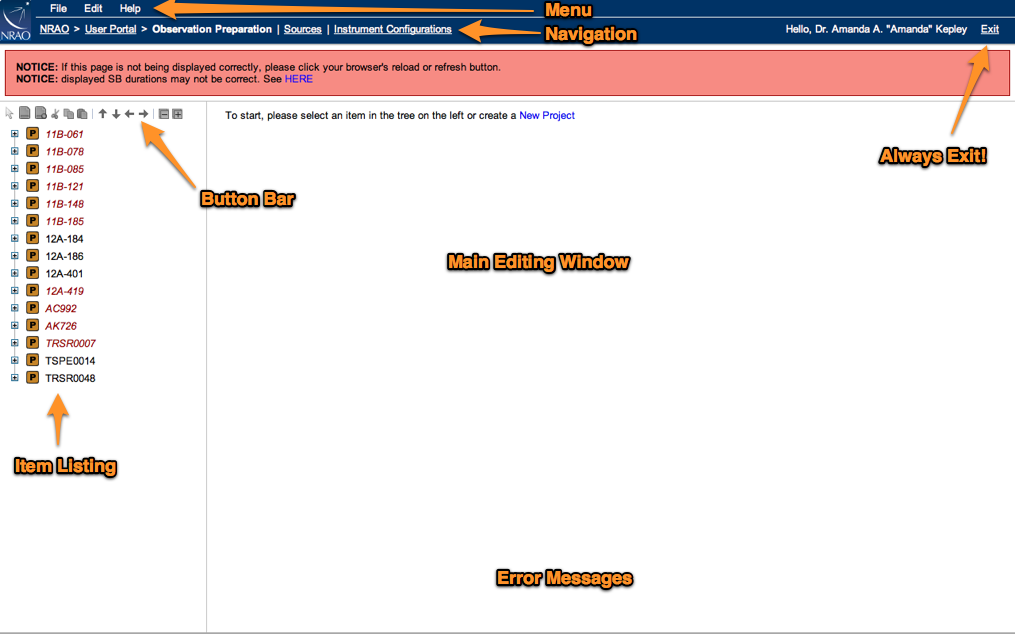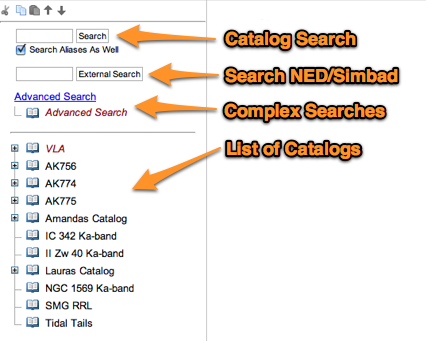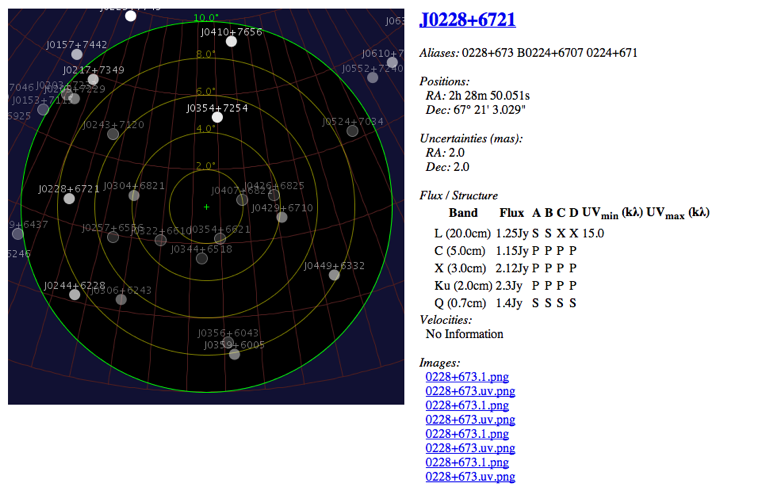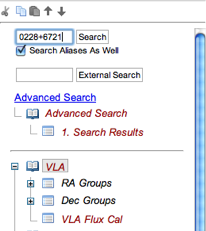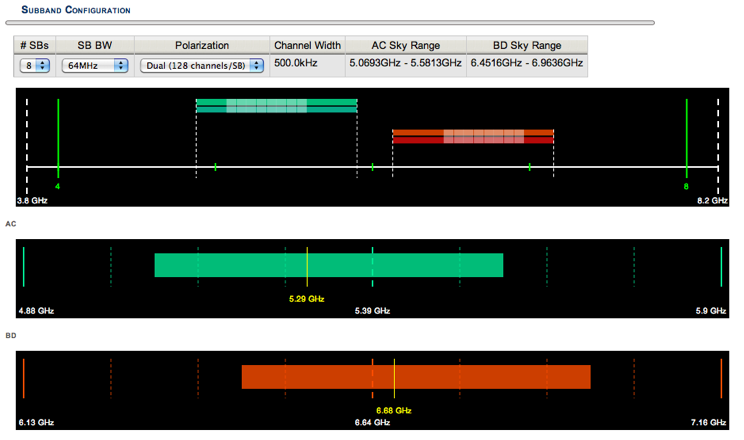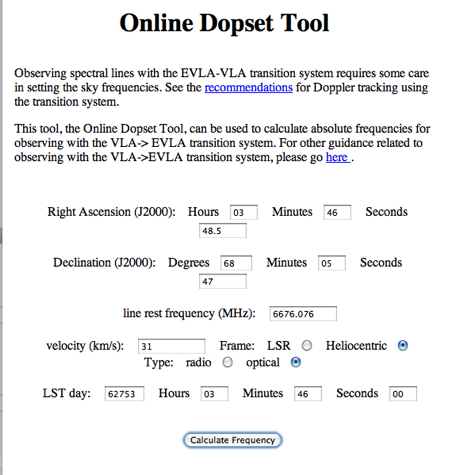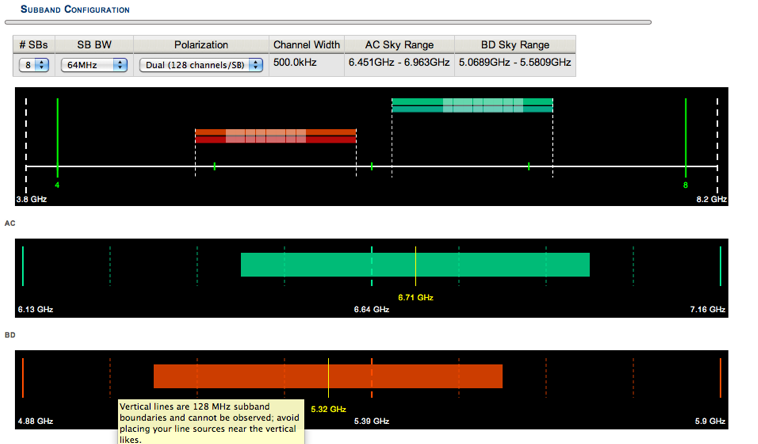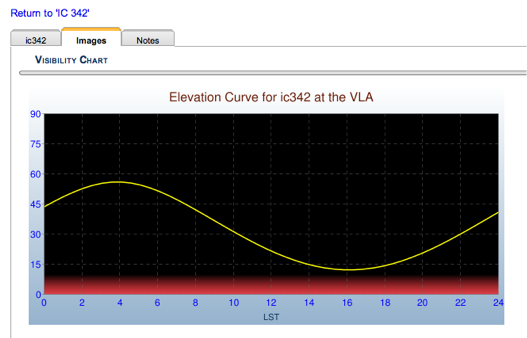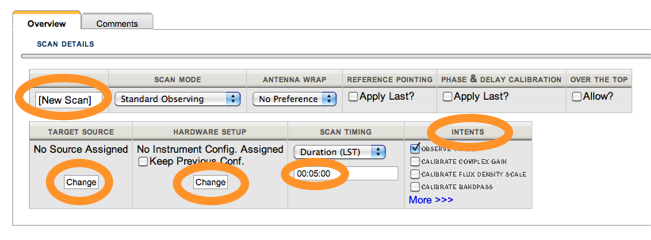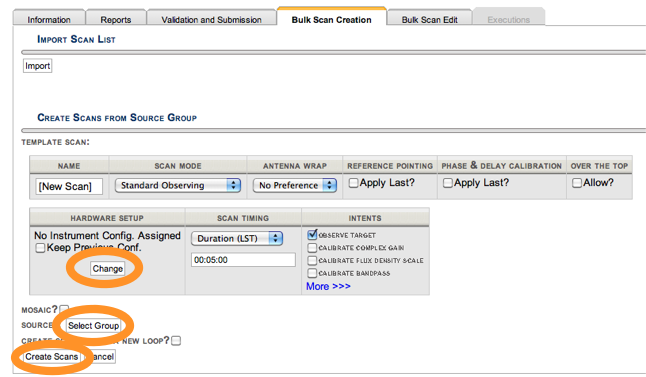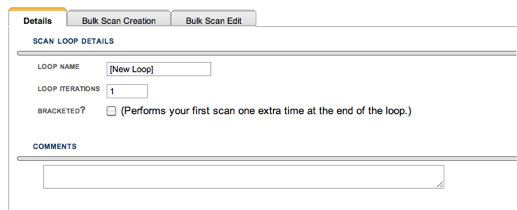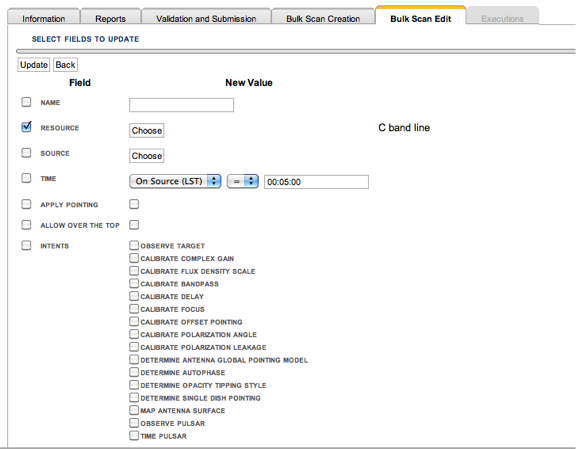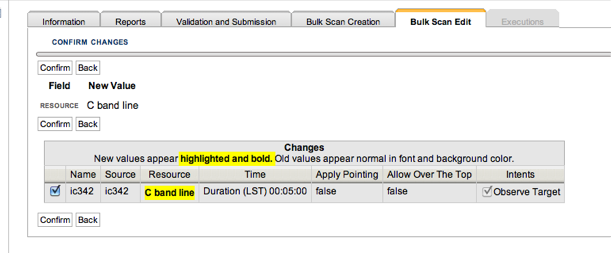Category:OPT-QuickStart: Difference between revisions
| Line 137: | Line 137: | ||
* In the first section of the instrument configuration page, | * In the first section of the instrument configuration page, | ||
** Give an appropriate name to the configuration. | ** Give an appropriate name to the configuration. | ||
** Select the appropriate receiver from the menu. You may see many errors at the bottom of the screen when you do this. These errors are usually the result of not having tuned your baseband yet, so you can safely ignore them for now (but not forever). | ** <p>Select the appropriate receiver from the menu. You may see many errors at the bottom of the screen when you do this. These errors are usually the result of not having tuned your baseband yet, so you can safely ignore them for now (but not forever).</p> <p>[[Image:correlator_name_band.png]]</p> | ||
[[Image:correlator_name_band.png]]< | |||
* It is easier to set the baseband frequencies once the graphical displays in the "Sub-band configuration" section are set up properly. Therefore, we will skip the "Frequencies" section of the configuration editor for now and move to the "Sub-band configuration" section. | * It is easier to set the baseband frequencies once the graphical displays in the "Sub-band configuration" section are set up properly. Therefore, we will skip the "Frequencies" section of the configuration editor for now and move to the "Sub-band configuration" section. | ||
** Select the appropriate number of sub-bands, sub-bands widths, and sub-band polarizations. Below the sub-band settings there are three plots. The first shows the location of your basebands. The 3 dB edges of the band are indicated by dotted lines. The green lines show the full sensitivity range of the basebands. The second plot shows the location of the sub-bands in your first baseband. The thin dotted lines indicate the edges of the sub-bands. If you hover your mouse over a particular sub-band, the center frequency of the sub-band will be labeled. The third plot shows the same thing for the second baseband. These plots are helpful for determining whether your correlator configuration is correct. | ** <p>Select the appropriate number of sub-bands, sub-bands widths, and sub-band polarizations. Below the sub-band settings there are three plots. The first shows the location of your basebands. The 3 dB edges of the band are indicated by dotted lines. The green lines show the full sensitivity range of the basebands. The second plot shows the location of the sub-bands in your first baseband. The thin dotted lines indicate the edges of the sub-bands. If you hover your mouse over a particular sub-band, the center frequency of the sub-band will be labeled. The third plot shows the same thing for the second baseband. These plots are helpful for determining whether your correlator configuration is correct.</p><p>[[Image:subband_configuration.png]]</p> | ||
[[Image:subband_configuration.png]]< | |||
* Now comes the difficult part -- tuning the basebands. Go to the "Frequencies" section of the configuration editor. The setup here is slightly different depending on whether you are doing line or continuum observations. | * Now comes the difficult part -- tuning the basebands. Go to the "Frequencies" section of the configuration editor. The setup here is slightly different depending on whether you are doing line or continuum observations. | ||
** For continuum observations: | ** For continuum observations: | ||
*** Select "sky" for the doppler setting mode. | *** Select "sky" for the doppler setting mode. | ||
*** Enter the desired continuum frequency for each baseband in the "SB Center Freq." box. The sky range for each baseband is shown in "BB Sky Range".[[Image:baseband_frequency.png]] | *** <p>Enter the desired continuum frequency for each baseband in the "SB Center Freq." box. The sky range for each baseband is shown in "BB Sky Range".</p> <p>[[Image:baseband_frequency.png]]</p> | ||
*** There are also default continuum configurations available for you to use in the "NRAO Defaults" group. The catalog name is currently "C/D/Any config 2x 1 GHz Full pol (11B OSRO)". You can use the copy and paste procedure to add these configuration to your personal catalog. The Observational Status Summary lists the [http://evlaguides.nrao.edu/index.php?title=Observational_Status_Summary#EVLA_Frequency_Bands_and_Tunability default continuum frequencies]. | *** There are also default continuum configurations available for you to use in the "NRAO Defaults" group. The catalog name is currently "C/D/Any config 2x 1 GHz Full pol (11B OSRO)". You can use the copy and paste procedure to add these configuration to your personal catalog. The Observational Status Summary lists the [http://evlaguides.nrao.edu/index.php?title=Observational_Status_Summary#EVLA_Frequency_Bands_and_Tunability default continuum frequencies]. | ||
** For spectral line observations: | ** For spectral line observations: | ||
| Line 157: | Line 155: | ||
**** Add an offset equal to 1/2 the width of a single sub-band to the sky frequency. | **** Add an offset equal to 1/2 the width of a single sub-band to the sky frequency. | ||
**** Enter the sky frequency plus the offset into the "SB Center Freq" boxes. IT IS VERY IMPORTANT THAT YOU DO NOT ENTER THE SKY FREQUENCY INTO THE "SB Center Freq" BOX. IF YOU DO THIS, YOU WILL PLACE YOUR LINE AT THE BOUNDARY OF THE TWO SUB-BANDS WHERE THE SENSITIVITY IS SIGNIFICANTLY DECREASED AND CALIBRATION BECOMES MUCH MORE DIFFICULT. Adding an offset of 1/2 the width of an individual sub-band places your line in the center of a sub-band. | **** Enter the sky frequency plus the offset into the "SB Center Freq" boxes. IT IS VERY IMPORTANT THAT YOU DO NOT ENTER THE SKY FREQUENCY INTO THE "SB Center Freq" BOX. IF YOU DO THIS, YOU WILL PLACE YOUR LINE AT THE BOUNDARY OF THE TWO SUB-BANDS WHERE THE SENSITIVITY IS SIGNIFICANTLY DECREASED AND CALIBRATION BECOMES MUCH MORE DIFFICULT. Adding an offset of 1/2 the width of an individual sub-band places your line in the center of a sub-band. | ||
**** In the example below, we calculated the sky frequency of the H99alpha (rest frequency = 9GHz) and H107alpha (rest frequency = 5.2937333GHz) RRLs for IC 342 on April 11, 2012 when the source will be at zenith. The sky frequencies are6.675026131 GHz and 5.292900816 GHz for the H99alpha and H107alpha lines, respectively. We added an offset equal to 1/2 the sub-band width (64 MHz/2 = 32 MHz) to the sky frequency to place the line in a sub-band rather than on a sub-band boundary. The final tuning frequencies are 6.707026131 GHz and 5.324900816 GHz.[[Image:dopset_input.png]] < | **** <p>In the example below, we calculated the sky frequency of the H99alpha (rest frequency = 9GHz) and H107alpha (rest frequency = 5.2937333GHz) RRLs for IC 342 on April 11, 2012 when the source will be at zenith. The sky frequencies are6.675026131 GHz and 5.292900816 GHz for the H99alpha and H107alpha lines, respectively. We added an offset equal to 1/2 the sub-band width (64 MHz/2 = 32 MHz) to the sky frequency to place the line in a sub-band rather than on a sub-band boundary. The final tuning frequencies are 6.707026131 GHz and 5.324900816 GHz.</p><p>[[Image:dopset_input.png]]</p><p>[[Image:dopset_output.png]]</p><p>[[Image:baseband_frequency_line_dopset.png]]</p><p> [[Image:subband_configuration_line_dopset.png]]</p> | ||
* Finally, you need to enter your integration time in the "Correlator Setup" section in the box labeled "integration time". This time depends on your array configuration and observing frequency. See the [https://science.nrao.edu/facilities/evla/observing/restrictions OSRO restrictions] to select the appropriate value for this parameter. There is additional information on this parameter in [http://evlaguides.nrao.edu/index.php?title=Observational_Status_Summary#Time-Averaging_Loss "Time Averaging Loss"] and [http://evlaguides.nrao.edu/index.php?title=Observational_Status_Summary#Time_Resolution_and_Data_Rates "Time Resolution and Data Rates"] sections of the Observational Status Summary. Please use the default integration time for your observing frequency and configuration. Do not use integration times shorter than the default unless it is necessary for your science. Shorter integration times lead to higher data rates, which is given in the "Correlator Setup" section under the integration time. It's a good idea to use this number to estimate the total data volume for an individual scheduling block and for your entire project. The EVLA produces much more data than the VLA. Large data files take a long time to download and process. For example, a 32GB data file takes about 8 hours to download over high-level broadband (10Mb/s) and about 1hr of computing time to run through a calibration script using CASA 3.4 on an computer with 12 processors, 24GB of RAM, and 2TB of disk space. Therefore, it is important to minimize your file sizes as much as possible. | * Finally, you need to enter your integration time in the "Correlator Setup" section in the box labeled "integration time". This time depends on your array configuration and observing frequency. See the [https://science.nrao.edu/facilities/evla/observing/restrictions OSRO restrictions] to select the appropriate value for this parameter. There is additional information on this parameter in [http://evlaguides.nrao.edu/index.php?title=Observational_Status_Summary#Time-Averaging_Loss "Time Averaging Loss"] and [http://evlaguides.nrao.edu/index.php?title=Observational_Status_Summary#Time_Resolution_and_Data_Rates "Time Resolution and Data Rates"] sections of the Observational Status Summary. Please use the default integration time for your observing frequency and configuration. Do not use integration times shorter than the default unless it is necessary for your science. Shorter integration times lead to higher data rates, which is given in the "Correlator Setup" section under the integration time. It's a good idea to use this number to estimate the total data volume for an individual scheduling block and for your entire project. The EVLA produces much more data than the VLA. Large data files take a long time to download and process. For example, a 32GB data file takes about 8 hours to download over high-level broadband (10Mb/s) and about 1hr of computing time to run through a calibration script using CASA 3.4 on an computer with 12 processors, 24GB of RAM, and 2TB of disk space. Therefore, it is important to minimize your file sizes as much as possible. | ||
| Line 165: | Line 163: | ||
* Go to the "Instrument Configuration" section of the OPT. | * Go to the "Instrument Configuration" section of the OPT. | ||
* Click on the "NRAO Defaults" catalog on the left hand side of the screen. | * Click on the "NRAO Defaults" catalog on the left hand side of the screen. | ||
* Click on the "Pointing setups" group in the left hand side of the screen. | * <p>Click on the "Pointing setups" group in the left hand side of the screen.</p><p> [[Image:pointing_setups.png]]</p> | ||
[[Image:pointing_setups.png]]< | |||
To aid in creating your scheduling block, it's useful to copy and paste the desired pointing setup into your personal instrument configuration catalog using the copy and paste method outlined in the calibrator selection section. | To aid in creating your scheduling block, it's useful to copy and paste the desired pointing setup into your personal instrument configuration catalog using the copy and paste method outlined in the calibrator selection section. | ||
Revision as of 20:06, 13 April 2012
Introduction
The goal of this guide is to provide a brief practical introduction to using the Observing Preparation Tool (OPT) to create scheduling blocks for the EVLA. After reading this guide, you should be able to successfully create a simple EVLA scheduling block. Please send any questions, comments, or suggestions about this documentation to akepley@nrao.edu.
A scheduling block defines a complete set of EVLA observations including your source observations and all necessary calibration (flux, complex gain, bandpass, etc). If you have experience with the old VLA, a scheduling block is the equivalent of an VLA "observe file" created using JObserve. Your total EVLA time allocation may consist of multiple scheduling blocks. Most scheduling blocks are scheduled dynamically based on the conditions at the EVLA.
This guide assumes that you understand what data is necessary to successfully calibrate your EVLA data. If you need a refresher, some helpful resources are:
- Taylor, Carilli, and Perley. 1999, Synthesis Imaging in Radio Astronomy II especially Chapter 5 -- Calibration and Editing and Chapter 11 -- Spectral Line Observing I: Introduction,
- EVLA observational status summary, which gives an overview of the EVLA including calibration, and
- the introduction to the VLA calibrator manual, which gives the best practices for calibrating EVLA data
This quickstart guide does not include the all current observing restrictions for the EVLA. These restrictions are given on the OPT web page and change frequently. Make sure you that you read and understand the current restrictions.
The OPT page also gives information on the latest features of the OPT. Since the OPT is being actively developed, some images may not be identical to those shown here. There may also be some additional features. However, the overall philosophy and workflow in the OPT should not change. If you need more information about any of the features described in this quick start guide, consult the full OPT manual. If you have questions about the OPT, you can submit a Help Desk ticket via my.nrao.edu.
Overview of the Scheduling Block Creation Process
There are three steps to creating a scheduling block.
- Create a catalog of the sources you would like to observe. This should include your science source(s) and your calibration sources (flux calibrator, bandpass calibrator, complex gain calibrator, etc).
- Configure the EVLA receivers and correlator for your proposed observations. An individual EVLA receiver and correlator setup is referred to as an instrument configuration.
- Create a scheduling block using the source catalog created in step 1 and the instrument configuration(s) created in step 2.
While completing these steps, keep a copy of your original proposal and your time allocation email handy. These documents should have all the information necessary to create your scheduling blocks.
OPT access and layout
To access the OPT,
- Login to my.nrao.edu. Your login should have already been created as part of the proposal application process. If you have forgotten your password, you can use the "Forgot password?" link to obtain your login information.
- Click on the "Obs Prep" tab.
- Click on the "Login to the Observation Preparation Tool" link.
You should now have access to the OPT. The layout of the OPT is shown below.
The different portions of the OPT are labeled in the above image. The Menu and Navigation strips occupy the top two lines of the screen. The Menu strip contains the usual "File", "Edit", and "Help" categories. Below it, the Navigation strip allows you to navigate to the different sections of the OPT:
- The Observation Preparation section where you prepare your scheduling blocks,
- The Sources section where you put together your source lists, and
- The Instrument Configuration section where you set up the receiver(s) and correlator configuration(s).
Any system-wide messages appear in red below the navigation strip. These messages alert users to system downtime, critical bugs, etc.
The item listing is in the left hand column. This list consists of either a list of scheduling blocks, instrument configurations, or source catalogs, depending on which section of the OPT you are in. The button bar above the item listing allow you to modify the item listing (e.g., cut, paste, copy, etc). You can hover the mouse over the different buttons to determine their function. Many of the button bar functions can also be accessed via the "File" and "Edit" menus.
The right hand column is your main editing window. In this window, you will set up scans in your scheduling block, add source information, and edit correlator configurations. Error messages will appear as necessary in the bottom portion of your screen.
WARNING: The OPT allows any co-investigator on your proposal to edit and submit scheduling blocks. However, only one individual can edit scheduling blocks at a time. To make sure that other members of your team are able to edit the scheduling blocks for your project, always click on the "EXIT" button in the upper right hand corner of the OPT to leave the OPT rather than just closing your browser window.
The OPT automatically saves your work. You can create your scheduling block in several shorter sessions rather than having to do everything at once.
Creating a Source List
To create a source list, click on "Sources" in the Navigation strip at the top of the screen. The item listing on the left hand side of the OPT will show your source catalogs. An example of this display is shown below. Your list of catalogs will be different from those shown. The only catalog that will be the same will the VLA catalog.
The list of sources from your accepted proposal are automatically imported into a catalog. The name of the catalog is the legacy ID for your proposal (e.g., AK774). The legacy ID for your proposal is given on the cover page of your proposal or in the list of submitted proposals in the Proposal Submission Tool at my.nrao.edu.
Note: You may have been awarded time for only some of your proposed sources. Regardless of the awarded time, all your proposed sources are imported in a catalog, not just those you were awarded time to observe.
Each catalog contains one or more groups of sources. Groups allow you to organize your source list and make it easier to generate scheduling blocks. For example, you can include the calibrators for your science source in the same group as your science source.
You can also manually add catalogs, groups, and sources using File->Create New. A newly created source only has fields for you to enter the source position and name. To add a source velocity to a newly created source, select File->Create New->Source Velocity. This will add a source velocity section to the source information in the editing window. Your source names need to be less than 14 characters for your data to be compatible with AIPS.
If you want to look at the parameters for or edit the sources in your catalog, click on the edit button to the left of the source name in the catalog as shown in the image below.
Most observations will need three different types of calibration sources: complex gain (i.e., phase) calibrators, flux calibrators, and bandpass calibrators. We will go through the process of selecting these different types of calibrators in the OPT. This will demonstrate both how to select these types of calibrators and the different ways to select sources from catalogs using the OPT.
Warning: Your observations may have different calibration needs than the above. It is your responsibility to make sure that your data will be adequately calibrated.
Selecting a Complex Gain Calibrator
Complex gain calibrators are used to calibrate amplitude and phase as a function of time. They are typically point sources located close (generally < 10 degrees) to the science source. The easiest way to select a complex gain (i.e., phase) calibrator is to click on the group containing your science source in the catalog for your observing program. To the right of your science source name in the main editing window, there will be a link to a map of the sky around your object (indicated below by an orange circle in the image below). Click on the link.
When you click on the "Sky Map" link, a separate window similar to the following will appear below. The left hand side shows all the calibration sources near your selected source. If you hover your mouse above a particular calibration source, you can get information on that source taken from VLA calibrator manual. See the VLA calibrator manual for a key to the catalog listing and for tips on selecting complex gain calibrators. Once you're selected a suitable source, write down the name of the source.
Warning: Clicking on the sky map will recenter it at those coordinates. Don't click on the map if you don't want to recenter it.
All VLA calibrators shown on the map are listed in the VLA catalog. To add the selected complex gain calibrator to the catalog for your project, search the VLA catalog for that calibrator and then copy and paste the complex gain calibrator information. To do this,
- Select the VLA catalog. This catalog should be at the top of your list of catalogs.
Type the calibrator name in the search box at the top of the item manipulation region.
- Click search. Your desired calibrator should appear in the main editing window.
- Click the check box next to the calibrator.
- Select Edit->Copy->Sources. You can also use the copy button (
 ) in the button bar.
) in the button bar. 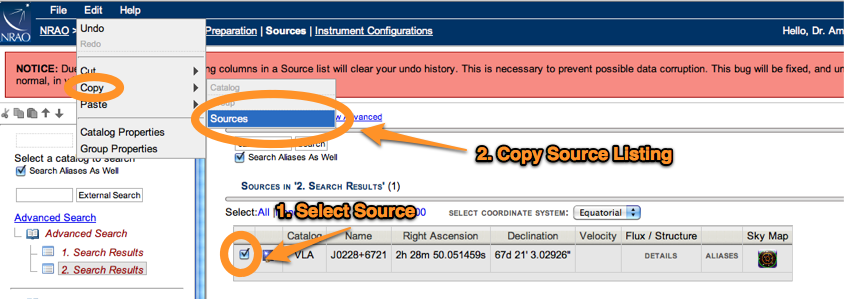
- Select the source catalog for your program.
- Select Edit->Paste->Sources. You can also use the paste button (
 ) in the button bar.
) in the button bar. 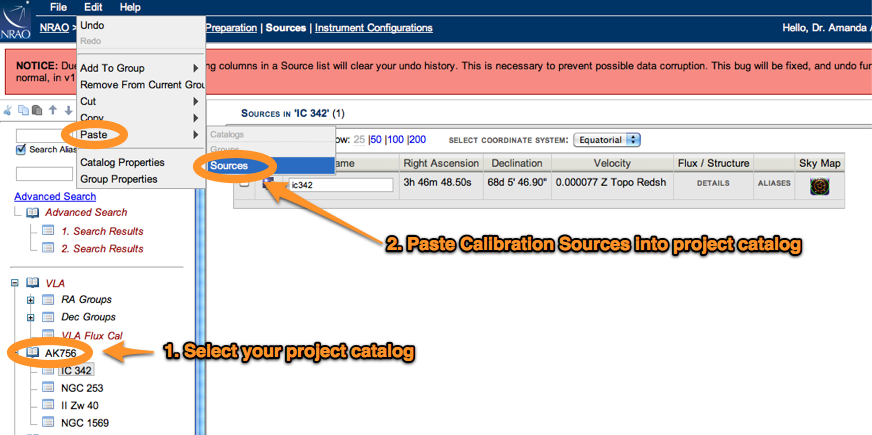
When you paste your source, the OPT will prompt you to choose the correct group for your calibrator. Select the correct group and click "Add To Group(s)" button. Grouping sources makes the book-keeping easier when creating scheduling blocks. If you want, you can also skip this step by clicking the "Skip This Step" button.
You can use a similar procedure as the above to add a source from NED or SIMBAD. Use the "External Search" box to find your source. Once you have found the appropriate source, follow the same procedure as above to copy and paste it into your catalog.
Selecting a Flux Calibrator
All the flux calibrators for the EVLA are located in the VLA catalog in the group "VLA Flux Cal". Choose an appropriate flux calibrator for your observations. Then use the copy and paste method detailed in the "Selecting a Complex Gain Calibrator" section to add your flux calibrator to your project catalog.
Selecting a Bandpass Calibrator
Objects like bandpass calibrators, which need to be very bright and up at the same time as your program source, require a more complex catalog search. (Sometimes your flux calibrator can be a suitable bandpass calibrator.) To do this type of search,
- Click on the "Advanced Search" link in the left hand column.
- Select the catalog you want to search. Here, we select the VLA catalog to search the VLA calibrator manual.
- Select the parameters you want to search on.
- Click on the "Search" button at the bottom of the page.
When you've found an appropriate source, you can copy and paste it into your program catalog using the same procedure as for your complex gain calibrator. In the example below, the VLA catalog is being searched for sources brighter than 5.0 Jy in C band with RA's between 0 and 6h and declinations greater than 30 degrees. 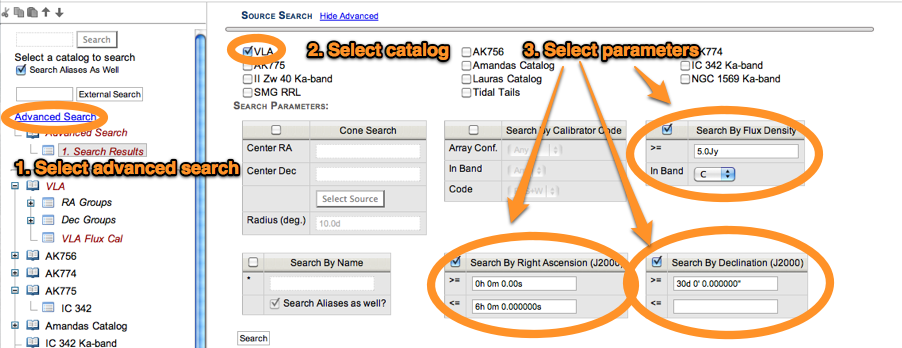
Setting up the Instrument Configuration
Configuring the receivers and correlator properly is one of the most important and difficult aspects of creating a scheduling block. Spectral line users should take extra care to ensure that their correlator set up is correct! Incorrect correlator setups may make doing your proposed science impossible. If you have any questions, please consult the NRAO helpdesk via the my.nrao.edu portal.
The EVLA WIDAR correlator is extraordinarily flexible. This quickstart guide only discusses the basic OSRO correlator modes. Although the general interface for configuring the correlator is similar for the RSRO modes, RSRO users should consult EVLA staff to create their correlator set up.
Correctly configuring the correlator requires a basic understanding of the WIDAR OSRO mode. In OSRO mode, you have two 1024 MHz wide basebands. In each baseband, you may place up to 8 adjacent sub-bands. The individual sub-bands can have widths ranging from 31.25 kHz to 128 MHz, but all sub-bands must have the same width. A critical point to remember is that the edges of each sub-band have reduced sensitivity. Do NOT place lines of interest on sub-band edges. You can change the number of channels in an individual sub-band by changing how many polarization products are recorded. If you are not interested in polarization, then dual polarization is a good setting.
If you are observing spectral lines, then you need to account for the motion of the Earth and the motion of the source when determining where to place lines (see Chapter 11of Taylor, Carilli, and Perley. 1999, Synthesis Imaging in Radio Astronomy II for a review of the different velocity systems). The old VLA used "doppler tracking". In doppler tracking mode, the sky frequency was changed for every scan so that the same rest frequency would always be in the same channel. The EVLA does not doppler track. Instead, you can either enter the sky frequency manually or use the doppler setting mode. To calculate the sky frequency of your line manually, you can use the dopset tool (http://www.vla.nrao.edu/astro/guides/dopset/). You need to enter the source position, the source velocity, the rest frequency of the line, and the observation date and time. The webpage then returns the appropriate sky frequency to enter into the instrument configuration editor. To get the LST day numbers, you can consult the monthly EVLA schedule. The LST days are given to the right of the schedule grid. To get the LST day numbers more than a month in advance, you can extrapolate from this schedule. In doppler setting mode, the appropriate sky frequency is automatically calculated once at the beginning of the scheduling block. However, unlike doppler tracking mode, the sky frequency is the same throughout the entire observation; it does not change with every scan. Doppler setting mode is configured using the instrument configuration editor.
Choosing whether to enter the sky frequency manually or to use doppler setting depends on your science and desired correlator settings. If your sub-bands are much wider than 30 km/s, then correction for the motion of the Earth is much smaller than the width of your sub-bands. Therefore, using doppler setting does not get you much and it is best to enter the sky frequency manually. You can account for the change in the sky frequency of the line with time in post-processing using a task like cvel in AIPS or CASA. Where doppler setting comes in handy is with narrower sub-bands (less than a few x 30 km/s). These sub-bands are small enough that the motion of the Earth may shift your line out of the sub-band. Doppler setting allows you to submit one scheduling block and have the line automatically be placed in the right spot. Otherwise, you would have to recalculate the sky frequency manually every few weeks and resubmit your scheduling block to account for the motion of the Earth. Note that doppler setting is more difficult to set up in the correlator (most of this complexity is hidden from the end user) and that RSRO users currently cannot use doppler setting.
To set up your instrument configuration,
- Click on the "Instrument Configuration" link in the navigation strip.
- Create a new instrument configuration catalog by going to File->Create New->Catalog.
- Create a new OSRO configuration by going to File ->Create New ->OSRO Configuration.
Your new correlator setup will be configured for continuum observing at X-band. However, the defaults are not particularly sensible (the basebands overlap and the sub-bands are not the maximum width), so you will want to change them even if you are observing continuum at X-band. After creating a new OSRO configuration, the OSRO configuration editor will appear in the main editing window. We will work our way through the instrument configuration settings starting at the top of the instrument configuration editor.
- In the first section of the instrument configuration page,
- It is easier to set the baseband frequencies once the graphical displays in the "Sub-band configuration" section are set up properly. Therefore, we will skip the "Frequencies" section of the configuration editor for now and move to the "Sub-band configuration" section.
Select the appropriate number of sub-bands, sub-bands widths, and sub-band polarizations. Below the sub-band settings there are three plots. The first shows the location of your basebands. The 3 dB edges of the band are indicated by dotted lines. The green lines show the full sensitivity range of the basebands. The second plot shows the location of the sub-bands in your first baseband. The thin dotted lines indicate the edges of the sub-bands. If you hover your mouse over a particular sub-band, the center frequency of the sub-band will be labeled. The third plot shows the same thing for the second baseband. These plots are helpful for determining whether your correlator configuration is correct.
- Now comes the difficult part -- tuning the basebands. Go to the "Frequencies" section of the configuration editor. The setup here is slightly different depending on whether you are doing line or continuum observations.
- For continuum observations:
- Select "sky" for the doppler setting mode.
Enter the desired continuum frequency for each baseband in the "SB Center Freq." box. The sky range for each baseband is shown in "BB Sky Range".
- There are also default continuum configurations available for you to use in the "NRAO Defaults" group. The catalog name is currently "C/D/Any config 2x 1 GHz Full pol (11B OSRO)". You can use the copy and paste procedure to add these configuration to your personal catalog. The Observational Status Summary lists the default continuum frequencies.
- For spectral line observations:
- If doppler setting,
- Select "rest" next to the baseband frequency.
You need to enter the rest frequency of the line for the baseband frequency AND an offset equal to half the width of a sub-band. If you do not enter an offset, you will place the line on the boundary between the 4th and 5th sub-bands (if you have 8 total sub-bands). The doppler setting algorithm uses the baseband center frequency to calculate the frequency. In the example below, we are using the doppler setting to tune to the H99alpha (rest frequency = 6.676076GHz) and H107alpha (rest frequency = 5.2937333GHz) RRLs. The lines are offset from the center of the baseband (and thus the edges of the sub-bands) by including an offset frequency that is half the width of the sub-bands.
- You need to enter the source information in the "Doppler Setting" section. You should already have this information in the source catalog you created earlier. To access your source catalog, click on the "select source" button and navigate to the appropriate source. Selecting "Configure separately" calculates the doppler correction separately for each baseband. Selecting "Configure together" uses the same doppler correction for both basebands. You will most likely want the "Configure separately" option.

- If entering the line frequency manually,
- Choose "sky" in the Frequencies section.
- Calculate the sky frequency manually using the dopset tool
- Add an offset equal to 1/2 the width of a single sub-band to the sky frequency.
- Enter the sky frequency plus the offset into the "SB Center Freq" boxes. IT IS VERY IMPORTANT THAT YOU DO NOT ENTER THE SKY FREQUENCY INTO THE "SB Center Freq" BOX. IF YOU DO THIS, YOU WILL PLACE YOUR LINE AT THE BOUNDARY OF THE TWO SUB-BANDS WHERE THE SENSITIVITY IS SIGNIFICANTLY DECREASED AND CALIBRATION BECOMES MUCH MORE DIFFICULT. Adding an offset of 1/2 the width of an individual sub-band places your line in the center of a sub-band.
In the example below, we calculated the sky frequency of the H99alpha (rest frequency = 9GHz) and H107alpha (rest frequency = 5.2937333GHz) RRLs for IC 342 on April 11, 2012 when the source will be at zenith. The sky frequencies are6.675026131 GHz and 5.292900816 GHz for the H99alpha and H107alpha lines, respectively. We added an offset equal to 1/2 the sub-band width (64 MHz/2 = 32 MHz) to the sky frequency to place the line in a sub-band rather than on a sub-band boundary. The final tuning frequencies are 6.707026131 GHz and 5.324900816 GHz.
- If doppler setting,
- For continuum observations:
- Finally, you need to enter your integration time in the "Correlator Setup" section in the box labeled "integration time". This time depends on your array configuration and observing frequency. See the OSRO restrictions to select the appropriate value for this parameter. There is additional information on this parameter in "Time Averaging Loss" and "Time Resolution and Data Rates" sections of the Observational Status Summary. Please use the default integration time for your observing frequency and configuration. Do not use integration times shorter than the default unless it is necessary for your science. Shorter integration times lead to higher data rates, which is given in the "Correlator Setup" section under the integration time. It's a good idea to use this number to estimate the total data volume for an individual scheduling block and for your entire project. The EVLA produces much more data than the VLA. Large data files take a long time to download and process. For example, a 32GB data file takes about 8 hours to download over high-level broadband (10Mb/s) and about 1hr of computing time to run through a calibration script using CASA 3.4 on an computer with 12 processors, 24GB of RAM, and 2TB of disk space. Therefore, it is important to minimize your file sizes as much as possible.
At high frequencies, you need to periodically obtain pointing solutions. These pointing solutions are typically obtained at C or X band. There is a NRAO-provided catalog of the default pointing setups. To access this catalog,
- Go to the "Instrument Configuration" section of the OPT.
- Click on the "NRAO Defaults" catalog on the left hand side of the screen.
Click on the "Pointing setups" group in the left hand side of the screen.
To aid in creating your scheduling block, it's useful to copy and paste the desired pointing setup into your personal instrument configuration catalog using the copy and paste method outlined in the calibrator selection section.
Putting It All Together: Creating a Scheduling Block
Before creating your scheduling block, please see the OPT webpage for the latest EVLA observing restrictions. These restrictions change frequently, so check back often to make sure you have the latest information.
The most basic restriction on your scheduling block is its length. The length of your scheduling block needs to be a multiple of 30min. Your scheduling blocks do not need to be the same length as the blocks listed in the email from the schedsoc committee. They can be as long or as short as necessary. The observing conditions may change significantly over the course of longer blocks (>4 hrs) while shorter blocks (<2 hrs) require higher overhead to obtain adequate calibration observations. To choose an appropriate scheduling block length, you need to balance your project's scientific needs and its science rating with your allocated EVLA time as a function of LST. Projects with lower ratings in popular LST ranges may want to schedule in shorter blocks to increase the probability that they are observed. The schedsoc page includes a link to the EVLA pressure histogram for your observing semester.
The EVLA requires an initial dummy scan to set the attenuation levels. The dummy scan should have a length of at least 1 minute and should have the same correlator set up as the first "real" scan. At high frequencies where pointing is required (>18 GHz), two dummy scans are required. Each should have a length of at least 1min. The first has the same correlator set up as the first "real" scan and the second has the same correlator set up as the pointing scans. If you have more than one science correlator setup, you need additional dummy scans for each correlator set up.
To create a scheduling block,
- Click on the "Observation Preparation" link in the navigation strip at the top of the screen.
- In the item listing on the left hand side of the OPT, click on the "+" side to the left of the project code for your proposal. Project codes are designated with an light brown box with a P inside it and have a format like 12A-186, (
 ).The code is listed on your proposal cover sheet and on the submitted proposals list in the Proposal Submission Tool.
).The code is listed on your proposal cover sheet and on the submitted proposals list in the Proposal Submission Tool. - In the level below the project code level, click on the plus sign to the left of project code to see the configurations for which you have be awarded time. These are referred to as program blocks and are designated by a blue box with the letters PB inside (
 ). The configuration for the program block will be indicated by a letter to the right of the icon. If your project can be observed in any configuration, you don't need to click on the relevant configuration to start to create a scheduling block.
). The configuration for the program block will be indicated by a letter to the right of the icon. If your project can be observed in any configuration, you don't need to click on the relevant configuration to start to create a scheduling block. - Finally, in the level below the program block level, click on the "+" sign next to the relevant configuration to start creating a scheduling block. Scheduling blocks are designated by a green box with the letters "SB" inside it (
 ). There should already be a scheduling block stub available. If you want to create a new scheduling block, go to File->Create New->Scheduling Block.
). There should already be a scheduling block stub available. If you want to create a new scheduling block, go to File->Create New->Scheduling Block.
The item listing on left hand side of the OPT display should now look similar to following 
The top level is the project code level, the next level down is the program block level, and the final level is the scheduling block level.
The first page you will see after you have created a new scheduling block is the 'Information' tab. There are three items you will likely change on this page:
- the name of the scheduling block,
- the LST start range, and
- the scheduling constraints/conditions.
The name of the scheduling block and the scheduling constraints/conditions boxes are self-explanatory. The LST restrictions are a little more subtle. To determine the LST start range for your scheduling block,
- Click on the "Sources" link in the navigation section of the OPT.
- Click on the catalog with your program sources in it.
- Click on the edit button for one of the source(s) that you will be observing in your scheduling block.
- In the editing window, click on the image tab to see the the elevation and azimuth curves for your source.

- Note the range of LSTs that your source is at an appropriate elevation/azimuth for observing.
Repeat this process for sources in your scheduling block including calibrators. The appropriate LST start range for your scheduling block is the range of LSTs during which all your science and calibration sources are up for the entire scheduling block. Make sure to take into account the length of your scheduling block into this consideration. If all your sources are up from 10h to 18h LST and your scheduling block is 4h long, then the appropriate LST start range is 10h to 14h.
Now go back to your scheduling block in the "Observation Preparation" section of the OPT. In the information tab for your scheduling block,
- uncheck the box for "no constraint"
- input the appropriate LST start ranges for your scheduling block making sure to take into account the length of your scheduling block.
You can input multiple LST ranges by clicking the "Add" button under the initial LST range. This is handy for avoiding LST ranges where your source is too high (elevation > 80 degrees).
One more thing to note in the Information tab is the "Count" entry under the scheduling block name. If you would like a scheduling block to execute multiple times, you can change the count from 1 to your desired number of executions. When submitting a scheduling block with multiple executions, you might consider submitting a block with a count of 1, checking the data after it has run, and then copying and pasting that scheduling block to a new scheduling block with a count greater than 1. Note that you cannot change the count on a scheduling block once it has been executed on the telescope.
Now that you have filled in the information tab, you are ready to add scans to your scheduling block. You can either create individual scans or you can create a number of scans at one time. To create an individual scan, click on the scheduling block and go to File->Create New-> Scan. Once you have created a scan, you should see something like the following:
The values that you most likely will want to change are shown in orange. Most of the values are self-explanatory. For the Target Source and Hardware Setup, you should click "Change" and then navigate to the appropriate catalogs and select the desired source or instrument configuration. You also should change the "intents" value to reflect the purpose of the scan. This will help with pipeline processing. If you are doing reference pointing, you should select "Interferometric pointing" under Scan Mode for pointing scans and select "Apply Last?" under Reference Pointing for source scans.
The "Bulk Scan Creation" allows you to create multiple scans with similar properties in one step. For example, if you have a group of sources that all have the same instrument configuration, you could use the "Bulk Scan Creation" tool to create multiple scans each with a different source but the same instrument configuration. This allows you to avoid having to create a new scan for each source, which could be very time-consuming depending on the number of sources. Another use of "Bulk Scan Creation" might be to import different mosaic pointings, but give them the same duration, scan intent, and instrument configuration.
To use "Bulk Scan Creation",
- click on the "Bulk Scan Creation" tab.
- Fill in the appropriate values in the "Create Scans From Source Group" section. The most likely of these are the Hardware setup and the Source group which are circled below in orange.
- Click on create scans.
- Edit the individual scans as needed.
Once you have created all the necessary scans for your scheduling block, you can arrange them using either cut and paste buttons or the arrow buttons at in the button bar to move scans around. The plus and minus buttons allow you to expand and collapse the scheduling block structure.
Scan loops are a useful way to repeat groups of observations. For example, you could put your science source and phase calibrator in a loop. Then you only need to create two scans and a loop rather than 2 times n scans. Unlike the VLA, a scan loop for the EVLA does not have any additional overhead. To create a scan loop, go to File->Create New->Scan Loop. You have a choice of where to put the scan loop (before or after a scan or possibly in another scan loop). If you click on the scan loop, you should see a screen similar to the following where you can set the properties of the scan loop.
If you want to change many scans at once, the "Bulk Scan Edit" option is very handy. To bulk edit scans, go to the "Bulk Scan Edit" tab in either the top level of a scheduling block or the top level of a loop. The bulk edit will only affect the scans in the structure that you are in. For example, if you click on "Bulk Scan Edit" in a loop, you will only bulk edit scans in that loop. If you click on "Bulk Scan Edit" in the top level of your scheduling block, it will bulk edit all the scans in your scheduling block. When you select the "Bulk Scan Edit" tab, you will see something like the following:
To bulk edit scans,
- Click on the fields that you would like to select on. In the example above, we have selected on the source name.
- Click select.
- Now click on the fields that you could like to change. In the example below, we have decided to change the resource used for this source.
- Now click "Update"
- A list of the changes that will be made will appear in the editing window. Click confirm to accept this changes and back to make further change to your selecting and editing parameters.
Warning: If you change one of your source catalog entries or instrument configurations in their respective sections, these changes do NOT automatically propagate to your scheduling block. You should bulk edit the affected scans in the observing preparation section of the OPT to update their source information or instrument configuration. The old and new sources and/or instrument configurations may have the same name. However, giving different names to the new sources and instrument configurations will help when double-checking your scheduling block.
Checking Your Scheduling Block
Congratulations on creating a scheduling block! Your scheduling block is automatically saved. If you decide to exit the OPT before submitting your scheduling block, the draft scheduling block will still be in the OPT when you return.
Before submitting your scheduling block, you should double-check and triple-check it to ensure that it is correct. Since your script will be run by the operator, there is no chance to change things once your scheduling block is on the telescope. The Report tab on the top level of your scheduling block contains a wealth of information on your scheduling block. We list some important items to check for the scheduling blocks below. If you have any questions about your scheduling block, please contact the NRAO helpdesk via the my.nrao.edu portal.
- Information tab:
- Is your LST start range appropriate? The easiest way to test this is use the "Assumed schedule start" field in the "Report" tab. You should step through the range of acceptable LST start times in half hour increments. Check that your sources are high enough and that you have enough time on source for each LST.
- Have you selected the appropriate scheduling constraints/conditions for your observing frequency?
- Report tab:
- Have you followed all the EVLA observing constraints listed on the OPT webpage including dummy scans, total time on first source, appropriate first and last sources?
- Is your scheduling block the correct length (multiple of 30 minutes)? You may need to enter an assumed schedule start time and click on update for the total scheduling block time to be updated.
- Is your source position correct?
- Is the position in the correct coordinate system (J2000 vs. B1950)?
- Is your source velocity correct?
- Is the source velocity in the correct coordinate system?
- Is your correlator configuration correct?
- Do you have an appropriate integration time?
- Have you selected the correct frequency?
- Have you selected "sky" vs. "rest" frequency as appropriate?
- Did you avoid placing your lines on sub-band edges? To see the frequency range and center frequency of each sub-band, select "Show all sub-bands" in the "Instrument Configuration" section.
- Is your total bandwidth correct?
- Is your channel width correct?
- Is your number of polarization products correct?
- Do you have the correct amount of time on source for all sources?
- Do your sources have the right instrument configurations associated with them?
- Are the scan intents set correctly for each source?
- At high frequencies, have you applied the reference pointing results to your source scans?
- Have you included all the appropriate calibration data (flux calibrator, complex gain calibrator, bandpass calibrator, etc)?
- Do you have enough time on the calibrator sources?
- Are your calibration sources bright enough?
- Is your complex gain calibrator approximately a point source at your observing frequency? This information is given in the VLA calibrator manual as the "calcode". See the VLA calibrator manualfor more details.
- Do your polarization calibration sources have the appropriate polarization properties at your observing frequencies?
- When stepping through the list of LST start ranges, do you have enough time on source for all scans (especially pointing and calibration scans)?
- When stepping through the list of LST start ranges, do you have any antenna shadowing warnings? Antenna shadowing occurs when one antenna blocks light going toward a second antenna. It is especially common in compact configurations for low declination sources. If a significant fraction of your antennas are shadowed for a particular LST start time, you may want to consider excluding that time from the range of acceptable LST start times. Shadowed antennas can be flagged.
- When stepping through the list of LST start ranges, do your sources have elevations of between 30 and 80 degrees if observing at high frequencies?
- When stepping through the list of LST start ranges, do your sources have elevations between 9 degrees and 80 degrees if observing at low frequencies?
- Are you in danger of hitting a wrap limit? The cabling inside the antennas has a finite length. This limits the angular distance that the antenna can rotate. When an antenna has rotated the maximum angular distance, it hits a "wrap limit" and has to rotate in the other direction to unwrap the cabling. The unwrapping process is slow and can take a significant amount (~10min) of time. Since the EVLA is dynamically scheduled, it is difficult to know where the antenna will be at the beginning of your scheduling block. To avoid hitting a wrap limit in the middle of your scheduling block, it is advisable to set the antenna wrap direction in the first 4-5 scans using the "antenna wrap" box in the scan information window editing window and assign some extra time to your first "real" scan. Then any unwrap will occur during the beginning of your block. The report tab will inform you whether or not the antenna is wrapping in the middle of a scheduling block.
Submitting Your Scheduling Block
To submit a scheduling block, click on the validation and submission tab in the "Observation Preparation" section. First, you need to validate the scheduling block. Once the scheduling block has been validated then you can submit it using the submit button at the bottom of the page. You can request help with your submission using the link to the NRAO helpdesk in the middle of the page.
To retract a scheduling block after its been submitted, go to the validation and submission tab for the scheduling block and click "cancel".
Once your scheduling block has been executed, you should receive an email from the EVLA Operator letting you know that the data has been taken and is available in the archive. You and your collaborators can configure your email settings by clicking on the project code on the left than side of the OPT and going to the "Principle Investigator and co-authors" section. The Executions tab on the scheduling block gives you information on when the block was executed.
Scheduling Block Examples
- Low Frequency (C band)
- High Frequency (Ka band)
About This Document
This document was originally created in Evernote, exported as HTML, and converted to mediawiki format using the Perl module HTML::WikiConverter. The illustrations were created using Skitch.
--Amanda Kepley 13:59, 12 April 2012 (PDT)
This category currently contains no pages or media.
